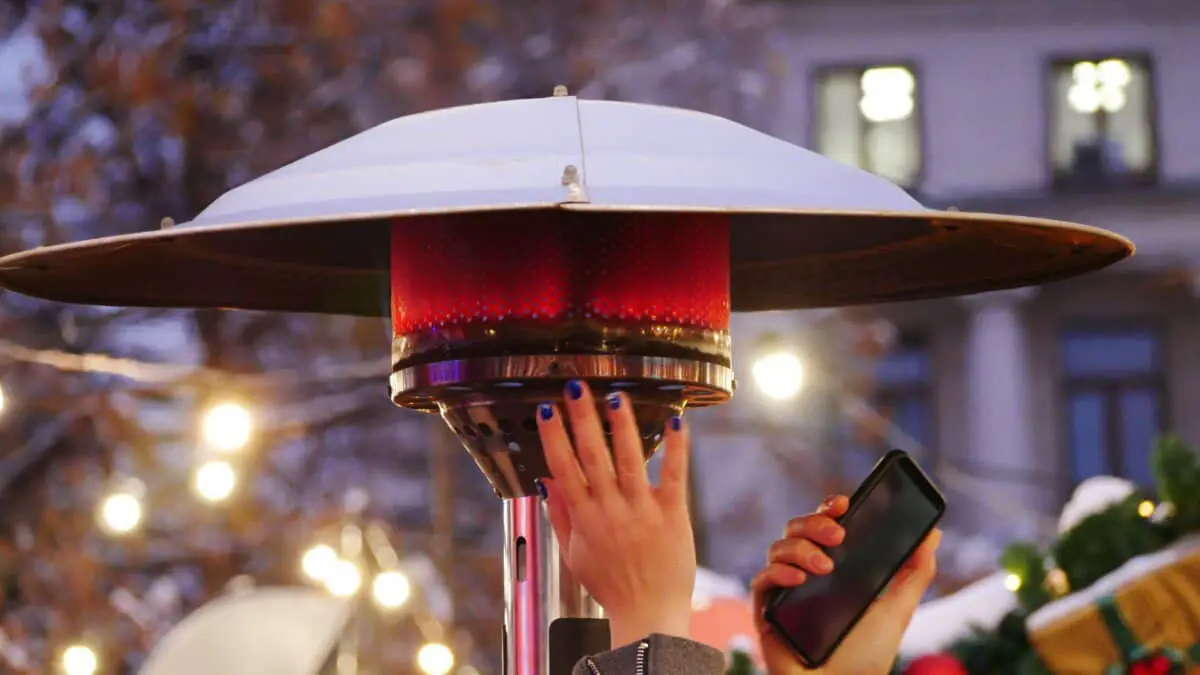While patio heaters may extend the hours we can enjoy outdoors, they also bring possible safety concerns. As these heaters grow in popularity, so do more stories of incidents related to them start to surface. Apart from “Where did you buy your patio heater?” the most asked question is “How safe is it?”
Patio heaters are safe to use as designed and instructed. The problems arise with neglect to maintenance, tank changes, and, I’m afraid to say, common sense.
Safety Tip List Based On Incidents
- Tip-Over & Center Of Gravity– not using a level, flat surface or adding extra weight to the base.
- Placed Close to Pets & Traffic – Heavy traffic areas can get the heater bumped or tipped.
- Left Unattended – Problems tend to arise when you are not there.
- Too Close To Heat Sensitive Materials – Placed too close to canopies, vinyl siding, or other melt-able or flammable materials.
- Proper Ventilation – Even clean-burning gas flame can use up the oxygen in the room.
- Testing For Gas Leaks – not taking the time to check for gas leaks, say, after a tank change.
- Proper Storage – preventing tip over and bugs out of heater components is vital.
- Covers – help in keeping your heater ready to use
As long as it does not become a fire hazard or cause an explosion because of a gas leak. Each type of patio heater has its own safety precautions that owners – or prospective owners – should take note of.
Searching for the safest patio heater available, I realized that the matter is not that simple. Some safety considerations are common to all types of patio heaters, while others relate to some types only. I arranged what I found out in a list of safety tips.
Patio Heater Safety Tip 1: Tip-Over and Center of Gravity
The most common safety concern is that your patio heater may fall over and cause injury or a fire. The way around that is to see how easy it will fall over if bumped into or if the wind picks up.
Most patio heaters have high centers of gravity, meaning they can easily tip – Choose one with a broad, more stable base and as short as you can have, but still be functional to you. Like are you going to stand under it or sit under it?
This is why almost all propane patio heaters have anti-tip shut-off built into them. So the risk of uncontrolled fire is remote.
Although, the top hat on a heater is very hot, and it could fall onto a person or a flammable object. Which could be a nasty injury.
A safety consideration related to the main point here is that one should position your patio heater on a flat surface. This makes it more difficult for it to capsize. It also helps if the surface is hard and stable (concrete or wood, for example) as opposed to more unstable ground (sand or uneven soil).
We typically set ours up on the grass, just off the walk area. I use a board to help level the base and then put anchors in the base to help prevent the heater from starting to tip.
Many patio heaters justify using a propane tank as weight. Still, as the propane tank empties, the counter-balance weight to lower the center of gravity is raised (or weakened). Meaning it’s more likely to tip when the tank is near empty.
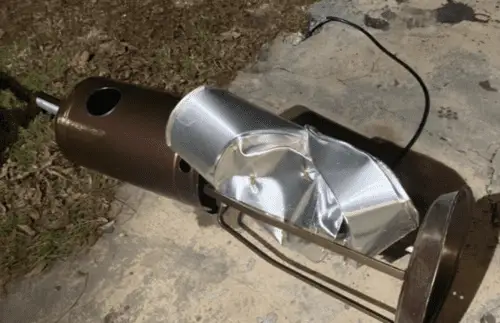
The wind is the main culprit when dealing with a tipping propane patio heater. And as the tank empties and the wind may pick up, tipping can happen quickly.
I would look for a brand/ model heater that offers the capability to fasten the heater down. Adding weight to a reservoir by using sand or water.
Solutions; I would look for RV antifreeze, or sand, if no tank, I would find a way to anchor the base level.
Here are some anti-tip anchor clamps you can add to your patio heater: This works best if you have one spot to place the heater and typically do not plan to move it around. See the kits here on BBQ Guys, click here.
If you are setting up a temporary heater in the yard, these nylon landscaping spikes work pretty well…Here they are at Home Depot.
I like using RV antifreeze in place of water. It does not freeze and is safer than any other antifreeze.
Here is RV antifreeze to use in place of water. RV antifreeze is less harmful to the environment compared to automotive antifreeze. Also, it is quicker than adding sand, and you never have to worry about freezing temperatures. Here is a link to RV antifreeze to check it out, but you may be able to buy it locally.
Patio Heater Safety Tip 2: Place Away From Human Traffic
Related to tip number 1 above is the fact that patio heaters are often put in areas that carry traffic – such as running kids and larger dogs. Therefore, ensure your patio heater is close enough to the area that you want to keep warm while stationing it well outside the high traffic flow area.
This point is also relevant for patio heaters in commercial areas where many people meet (such as restaurants, for example). A general rule here is that patio heaters must be stationed more than 5 ft. from exits and entrances. If there is only one access way, increase the distance from the access way to 10ft.
This is to avoid a fire hazard in case people have to evacuate for other reasons – such as emergencies caused by a burst water pipe.
The solutions in Tip #1 are the remedy here as well.
Patio Heater Safety Tip 3: Do Not Leave Heater Unattended
It is never good or safe practice to leave patio heaters unattended. It is essential to keep an eye on kids and pets whenever your patio heater is in use.
Keep a fire extinguisher nearby for emergencies too. Plus, shut off the heater before moving it.
Keep an eye on the wind speed. If the wind picks up, that might cause your patio heater to tilt over and cause damage before you notice it.
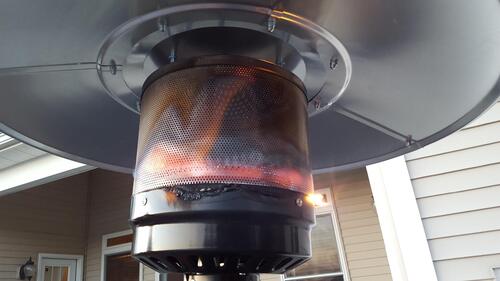
I feel the main thing here is to make sure, for example, let’s say something like the flame goes out, but the pilot still sees heat, allowing gas to keep venting out. So now, a bunch of un-ignited propane gas is floating around.
The main solution is to shut it down when you’re not around!
Patio Heater Safety Tip 4: Distance From Flammable Materials
The more pleasant a conversation gets, the less we pay attention to what is happening near the patio heater. For this reason, it is vital to make sure you think ahead of time. While you can still give all your attention to the heater and that there is no flammable material anywhere near your patio heater.
Here we specifically mention paper (decorations, for example), plastics (vinyl siding or shade sheets), materials (awnings or curtains), and wood (ceilings). These can all catch fire or distort. Even glass in windows will not work well near the heater.
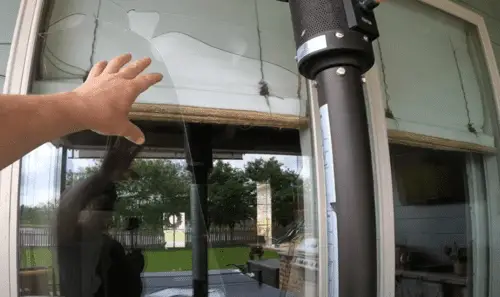
However, the real problem may be your home’s warped vinyl siding or soffit. A canopy may warp and weaken or give way from being fastened. The repairs can be costly compared to just thinking ahead about the heat output from your heater.
If your limited for room and placement you can get a Patio Heater Reflector to minimize heat near the sensitive areas like the vinyl siding. read more about our article on Patio Heater Reflectors, Do They Really Work?
Also, you can pick up an IR temperature probe and double-check your temperature outputs. Check the one I got at Amazon; click here. You can also pick them up at Harbor Freight; click here.
It is recommended that an area of 3ft. be left clear on all sides of the patio heater at the very least.
For commercial applications, as a note, it is well to note that the law prohibits patio heaters within 20 ft. from automotive service station gas dispensers. In case you run a gas station?
Solution for tip 4, Just think ahead, what can melt if the temperature gets above, say, 100 to 300 degrees.
Patio Heater Safety Tip 5: Proper Air Ventilation
A propane patio heater is designed to provide heat to an outside area or open-air area. Using a propane patio heater while the fuel is safer to breathe than, say fuel oil heater. The burning of propane does generate CO (Carbon Monoxide). A perfect burning flame can produce CO2 (Carbon Dioxide). While not poisonous, it deprives the oxygen from the room.
So, always make sure you have a fresh air source.
Fresh air outside – no special preparation needed for air quality.
Fresh air in an enclosed or winterized porch – ensure you have at least 1 square foot of fresh air in the space open to fresh air for every 10,000 BTUs of heater output.
Enclosed insulated area – do not use your propane patio heater. Step up to an electric model if you need radiant heat in that room.
Electric patio heaters do not need to be ventilated, as they do not produce open flames or fumes. However, bear in mind that propane patio heaters are specifically designed for use in open and semi-open spaces
Check out our article on electric patio heaters Best Electric Patio Heaters, Our 5 Picks
A very sobering thought in this regard is that one gas heater produces similar amounts of carbon dioxide per year as a speeding truck: over 200 000 tons. Trucks and cars produce other harmful emissions you do not want to breathe, so they lose the green race over the heater. Rather be on the safe side of this number, and keep your gas patio heater well ventilated!
Solution for tip 5; only use your patio heater for making warm spaces outside.
Patio Heater Safety Tip 6: Testing For Gas Leaks
If you smell gas, do not proceed. This means there may be a gas leak on your patio heater, which could lead to an explosion. Instead, carefully turn off the tank knob and let things ventilate naturally. In this case, keeping it away from open flames or electric spark of any kind is best. For added safety, you could seek an expert to investigate.
If you want to investigate further, you can test for leaks by applying soapy water. This will exhibit bubbles where the leak is. Sometimes allowing it to sit for a minute or two will enable small leaks to bubble up for easy visibility.
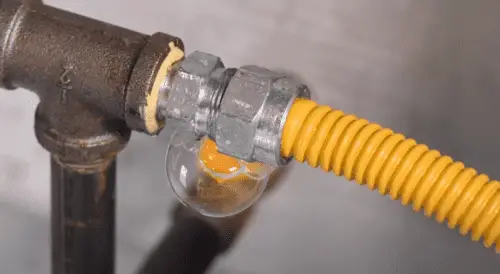
A soapy solution in a spray bottle works fantastic for this. You can use an old glass cleaner bottle and mix some dish soap liquid with water, give it a shake, and spray away.
The main problem areas are typically the following:
- The connection point where the hose connects to the tank.
- Where the regulator is along with the hose connections on either side.
- Where the hose connects to the burner area.
- The thermocouple is bad.
- Trying to light too often or holding the knob in too long.
Also, make sure you move the faulty heater to an open-air area, as you do not want to be overpowered by the smell of leaking gas.
From a more practical, preventative point of view, do not keep trying to light a gas unit up if it fails to start. Instead, give it a few minutes, and try again. This way, you prevent a gas build-up that may lead to a possible explosion.
The solution for a gas leak on a propane patio heater is to check with soapy water before you try to light it.
If you need an industrial spray bottle check these we have bought on Amazon…Click here for spray bottle.
Patio Heater Safety Tip 7: Proper & Safe Storage
As pointed out above, patio heaters can explode. However, with all safety devices working and common sense used, an explosion is very unlikely. So here is how you can store a propane patio heater to keep future problems at a minimum.
Even when not being used, the main problem is tipping and bending the heat deflector or knocking something loose. So, #1 is preventing tipping. When stored in a garage, it can be good to use a small diameter rope and tie them up in a vertical position.
Bugs and rodents may be a problem depending on when you are storing them. Bugs can build their nest or cocoon, I will call it. This can block proper venting and make the flame burn wrong and uneven or not even where it is supposed to burn.
Always store with the tank off.
Apart from the precaution mentioned in Tip 6 above, it is better to store gas units (especially their gas cylinders) in a dry, protected, ventilated outside space. Also, be careful and store the cylinders upright.
Electric heaters are better able to withstand outdoor conditions and have been known to survive even torrential rain. However, it is not advised to leave these units in the rain simply because the elements induce wear and tear on all the electrical component equipment.
Solution for long-term storage, make sure the tank is off or removed and tie them up so they can not tip.
Patio Heater Safety Tip 8: Protective Covers For Your Heater
Patio heaters are well protected from heat with ventilation or insulation. But what can a cover actually provide?
Many covers come with the patio heater as a selling point. However, covers do help with the following.
- Protection from color fade (for colored models)
- Reduction of pests getting into the components
- Reduction in wind forces upon the heater to help prevent tipping
This simply represents good care and makes for a longer lifetime of enjoyment.

Here is the cover we bought for the one heater we got that did not come with its own cover. It is nice. It mentioned that it would fit the Amazon Basics heater at the time of purchase, so it did fit correctly. I recommend matching or proving a cover that corresponds to the manufacturer of your heater. The color is more dark gray than it is jet black that it looks like in the picture on Amazon.
The main thing to measure for a patio heater cover is:
- the top hat diameter.
- The overall height
- Then the tank area diameter
Solution for prevention of bugs and discoloration. Always put your cover on the next day after use.
There are a ton of covers and sizes available in different colors, check Amazon for the selection available
Common Sense or Poka-Yoke Your Patio Heater
Poka-Yoke is a term often used in the manufacturing industry. It is the Japanese word for “error proofing“. For example, Most well-manufactured patio heaters have error-proofing features. An example is a gas patio heater that shuts down automatically if the unit is tilted for some reason.
Look for these features because they give an added layer of protection against unexpected incidents.
Some units also provide emergency stop buttons. These are not automated, but do at least provide the opportunity to immediately shut down the heater where unexpected incidents may occur.
Safety is primarily a common-sense approach. Taking a couple extra steps to prevent problems is the easiest way to fix them.
Conclusion
The patio heater is a beneficial asset to have around your home. It undoubtedly extends our outdoor time – especially during the past pandemic, when being indoors most of the time became a bit suffocating or overwhelming.
But, like with all assets, the enjoyment comes the responsibility. The responsibilities of owning a propane patio heater are not complicated. They essentially come down to one crucial point: Safety. So, follow along, and your heater should work well and be safe always.
Check out this article if you are having problems with your thermocouple. Learning how to clean one could save you hundreds.
How To Clean A Thermocouple On A Patio Heater
Or this article on…


